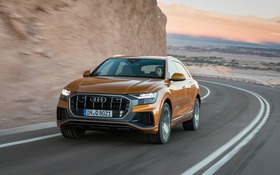2019 Audi Q8: The New Face of Audi SUVs

| Strong points |
|
|---|---|
| Weak points |
|
BMW has the X6, Mercedes-Benz has the GLE Coupe, and now Audi will introduce its Q8 to Canada in the first quarter of 2019. Foreshadowed by the Q8 sport concept unveiled at the Geneva Auto Show in March 2017, the new Q8 borrows several features from the recent A6, A7 and A8. It shares the same platform with the Bentley Bentayga and Lamborghini Urus, which also fall under the Volkswagen Group.
The Q8 is shorter, lower and wider than the Q7, but the two vehicles have an identical wheelbase that measures nearly three metres. From a style perspective, the Q8 ushers in the new face of the brand’s SUVs, with a wider and lower grille featuring six vertical chrome bars and an outline that matches the body on the base version or comes in platinum grey on the S line versions.
Note the flares above the fenders, the trapezoidal shape of the C-pillar and the black strip that connects the tail lights, all of which are reminiscent of the legendary 1985 Audi Sport Quattro. The Q8’s proportions are more balanced than those of the Q7 and the rift between the two is pretty spectacular.

Very spacious
From a practical point of view, the new Q8 now offers more space than its direct rivals, with more than satisfactory legroom for the rear passengers thanks to the very generous wheelbase. The cargo volume is 605 litres with all seats in place and 1755 litres when the rear seatbacks are lowered. The power hatch comes standard.
The dashboard borrows its three digital screens from the recent A8, A7 and A6. The first is the Audi virtual cockpit that replaces the conventional instrument cluster. The other two are high-definition colour touchscreens with acoustic and haptic feedback. The 10.1-inch upper screen acts as the interface with navigation, infotainment and communication functions, while the 8.6-inch lower screen controls the climate control system, heated and ventilated seats and activates certain devices like the hill descent control system. There are two USB ports as well as SIM card and SD ports under the central armrest.
Quiet, we’re driving!
We tested the Q8 in the Atacama Desert and our trip saw us travel more than 4000 metres in altitude. The Q8 proved very quiet on the deserted back roads, even as our speed flew well above the 100 km/h mark. It’s particularly impressive when you consider that the doors are devoid of frames and acoustic glass. The large rearview mirrors are streamlined, making the ride that much quieter.
The only engine available in Canada is the 340-horsepower twin-turbo V6 – the same one that equips the A8, A7 and A6. It’s paired with an eight-speed automatic transmission and all-wheel drive. Considering the Q8’s sportier purpose, the power and torque of this engine seemed barely sufficient for a vehicle that weighs 2175 kg (more than two metric tonnes).
Did the thinner air at high altitude play against the Q8 and its twin-turbo engine? I can’t help but think that this vehicle should have gotten the A8’s twin-turbo V8, especially since its purpose is to offer a sportier, more dynamic ride than the Q7. More on that another time.
Wondering about fuel consumption? We recorded an average of 11.3 litres per 100 kilometres on a rather atypical route. The Q8 features the 48-volt electrical system and mild hybrid device developed for the manufacturer’s recent A8 luxury sedan. This mild hybrid system uses an alternator/starter and a lithium-ion battery to recover kinetic energy during braking and recharge the battery. The stored energy can then be deployed during acceleration or used to help maintain cruising speed, which helps reduce fuel consumption.

The Q8 has three possible suspensions. The first is made up of conventional steel springs and adaptive dampers. The other two are adaptive air suspensions that help lower the body at highway speeds to improve aerodynamics or raise it up to 50 millimetres for driving on trails.
The Q8’s handling is configurable using Audi drive select. It helps calibrate the ride with seven different modes, including one called Individual, which lets you customize the settings. This is the most interesting mode because it lets you opt for more dynamic calibrations for the steering, accelerator response and gearbox, all while setting the adaptive suspension to Comfort mode.
This was the mode that we used most of the time, except when we went off road and repeatedly crossed a river—Offroad mode made more sense for that. The Q8’s ride is much more dynamic than that of the Q7 due to its faster steering and optional four-wheel drive system.
More dynamic and sportier than the Q7, the Q8 helps Audi broaden its horizons in the SUV segment. With this vehicle, Audi is making up lost ground to compete against its direct rivals who already offer coupe-like SUVs. Since the Q8 won’t arrive in Canada until 2019, the price range is as yet undetermined. However, it is expected to cost about 5% more than the Q7, which means we can anticipate a starting price of about $75,000.











